All Photos(1)
About This Item
Empirical Formula (Hill Notation):
C10H16N2O3S
CAS Number:
Molecular Weight:
244.31
MDL number:
UNSPSC Code:
41116133
NACRES:
NA.43
Recommended Products
Assay
≥97% (by assay)
Quality Level
form
solid
manufacturer/tradename
Calbiochem®
storage condition
OK to freeze
color
white
solubility
water: 1 mg/mL
cation traces
heavy metals: ≤0.001%
shipped in
ambient
storage temp.
2-8°C
InChI
1S/C10H16N2O3S/c13-8(14)4-2-1-3-7-9-6(5-16-7)11-10(15)12-9/h6-7,9H,1-5H2,(H,13,14)(H2,11,12,15)
InChI key
YBJHBAHKTGYVGT-UHFFFAOYSA-N
Related Categories
General description
A sulfur-containing vitamin that plays a role in numerous carboxylation and deamination reactions.
Growth factor that plays a role in numerous naturally occurring carboxylation reactions.
Warning
Toxicity: Standard Handling (A)
Reconstitution
Following reconstitution, refrigerate (4°C). Stock solutions are stable for up to 2 months at 4°C.
Legal Information
CALBIOCHEM is a registered trademark of Merck KGaA, Darmstadt, Germany
Storage Class Code
11 - Combustible Solids
WGK
WGK 1
Flash Point(F)
Not applicable
Flash Point(C)
Not applicable
Certificates of Analysis (COA)
Search for Certificates of Analysis (COA) by entering the products Lot/Batch Number. Lot and Batch Numbers can be found on a product’s label following the words ‘Lot’ or ‘Batch’.
Already Own This Product?
Find documentation for the products that you have recently purchased in the Document Library.
Customers Also Viewed
Mohd Anisul et al.
eLife, 10 (2021-08-18)
The virus SARS-CoV-2 can exploit biological vulnerabilities (e.g. host proteins) in susceptible hosts that predispose to the development of severe COVID-19. To identify host proteins that may contribute to the risk of severe COVID-19, we undertook proteome-wide genetic colocalisation tests
Paniz Izadi et al.
iScience, 24(8), 102822-102822 (2021-08-03)
The formation of combined electrogenic/electrotrophic biofilms from marine sediments for the development of microbial energy storage systems was studied. Sediment samples from the German coasts of the Baltic and the North Sea were used as inocula for biofilm formation. Anodic
Chun-Min Shan et al.
Cell reports, 35(7), 109137-109137 (2021-05-20)
Oncogenic histone lysine-to-methionine mutations block the methylation of their corresponding lysine residues on wild-type histones. One attractive model is that these mutations sequester histone methyltransferases, but genome-wide studies show that mutant histones and histone methyltransferases often do not colocalize. Using
Our team of scientists has experience in all areas of research including Life Science, Material Science, Chemical Synthesis, Chromatography, Analytical and many others.
Contact Technical Service





